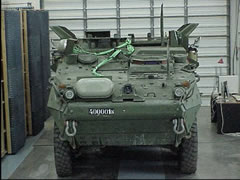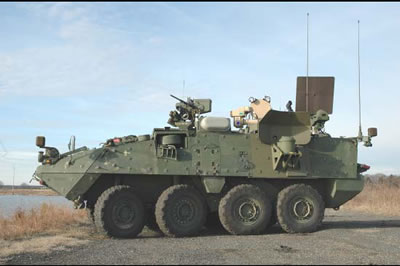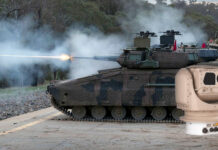The Armed Services Committee of the U.S. Congress received today (Sept 21, 2006) a series of briefings by representatives from the Office of the Secretary of Defense and U.S. Army. The purpose of the hearings was to provide the subcommittee of tactical air and land forces an insight into the need, availability and requirements of active protection systems with the current and future force.
Dr. Robert Buhrkuhl, Director, Joint Rapid Acquisition Cell, Office of the Secretary of Defense briefed the committee about the Full Spectrum Effects Platform (FSEP) known as “Project Sheriff”. After evaluating a number of potential systems, the Office of Force Transformation estimated that the General Dynamics/RAFAEL Trophy system could be fielded on one vehicle in the first half of 2007. Army and OSD’s Joint Rapid Acquisition Cell recommended against continued testing of Trophy because of technical and collateral damage issues, and that the Central Command urgent requirement could not be met until, at the earliest, the 2011 fielding of the active protection system being developed for the Army’s Future Combat Systems Program. He alluded to the fact that two of the key systems required for FSEP Spiral 1, the Active Protection Systems (APS) and Active Denial System (ADS), both millimeter-wave emitting systems, originally scheduled for fielding by the first half of 2007, were not mature enough.
 Adequate Defense Against RPGs
Adequate Defense Against RPGs
Major General Jeff Sorenson, Deputy Assistant Secretary of the Army (Acquisition, Logistics and Technology) told the committee that the Army has been working on threat countermeasure systems for the past 40 years. He argued that the army’s heavy combat systems continue to be effective against RPG attacks thanks to the effectiveness of the force protection capabilities already deployed. “To date, the Army has fielded to theater 950 sets of Bradley Reactive Armor Tiles, 1097 sets of M113 Slat Armor Kits, and two brigades of Stryker Slat Armor Kits. The first sets of Stryker Reactive Armor Tiles will be available for fielding in October 2006 and the first sets of Abrams Reactive Armor Tiles will be available for fielding to theater in June 2007. As evidenced by the low casualty rate of Soldiers using our combat systems, General Sorenson claimed only 10 of the 148 killed in action since 2003 by RPG attacks could have been avoided, if active protection systems were deployed. According to General Sorenson, the Trophy system, which starred in media coverage, is merely an engineering development model, and is not yet mature for deployment. Even if such system was deployed it could be used only with the heavily armored vehicles, such as Abrams, Bradley and Stryker.
Survivability – A Long Term Approach
General Sorenson explained the Army’s assessment of the future threat and the role of a holistic future full spectrum protection approach towards survivability. The Army is leveraging the network for improved situational awareness, reducing signature management, improving ballistic protection, modifying operational tactics, and pursuing hit avoidance. APS is considered as a central element of hit avoidance, comprising technologies that enable defeat of the threat prior to its impact with the vehicle. “The hit avoidance requirement for our future force is a 360-degree hemispherical “bubble” of protection to our combat platforms.” explains General Sorenson.
APS development efforts of the Science and Technology community, Ground Combat Systems program office, and FCS Brigade Combat Team (BCT) program are tightly aligned to ensure that the Army will have near-term close-in active protection for the current force, (Abrams, Bradley, and Stryker) while pursuing full-spectrum survivability and hit avoidance capabilities for the future family of manned ground vehicles as part of the Future Combat systems (FCS) program. Currently, the FCS program is developing a full-spectrum solution to counter short- and long-range threats, which include a wide range of ballistic projectiles: RPGs, mortars, antitank guided missiles, tank-KE/HEAT, top attack/precision guided missiles, and large caliber cannon.
Operational Aspects
Collateral damage against Soldiers and non-combatants is a major, especially when forces are deployed in confined urban environments. The tactics, techniques, and procedures to safely and effectively employ of APS are yet to be developed. For example, rules of engagement always provide for self defense. However, those same rules of engagement direct forces to limit or prevent noncombatant casualties and injuries. Employment of an APS system creates a challenge to solve these two fundamental rules simultaneously. “We are seeking answers to questions of use of APS systems in urban settings with civilian crowds. We are considering the implications of employing dismounted soldiers around or near vehicles with an APS to prevent fratricide.” General Sorenson told the Committee.
APS Systems Availability
“The number of systems that are suitable, reliable, safe and able to be integrated in the near future into our current combat systems is a very small subset of the worldwide APS development continuum.” Says General Sorenson. There are roughly 20 U.S. and foreign-based active protection systems under various stages of development, differing from each other in terms of concept of operation and the resulting collateral damage geometry. Each system must be addressed with its unique space, weight and power for vehicle integration. Additionally, each system has a unique collateral damage geometry that must be minimized in order to ensure the safety of our Soldiers, non combatants and the system.
One of these systems is the Quick Kill, developed by Raytheon and selected by the FCS integrator to provide a future solution for the FCS program. “Quick Kill, with its vertical launch and fire control capabilities, is best suited to support current force active protection ground combat system requirements and concurrently support the Future Combat Systems hit avoidance suite and full spectrum survivability requirements.” Said General Sorenson. The system provides 360-degree all-aspect protection, from multiple simultaneous threats. To date, the Quick Kill system has demonstrated successful warhead, compound maneuver, radar integration and RPG intercept tests using an advanced detection and tracking capability that incorporates precision fire-control algorithms and vertical launch interception. Currently the Army plans to provide prototypes and conduct a Limited User Test in 2010.




















